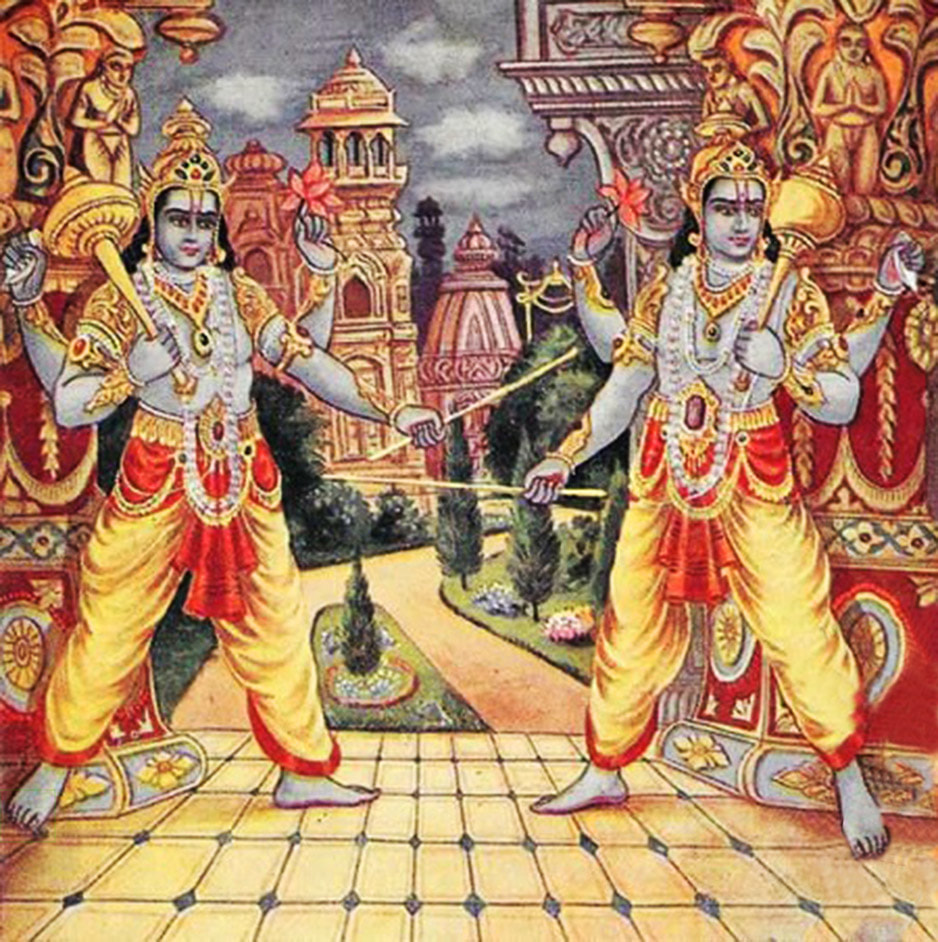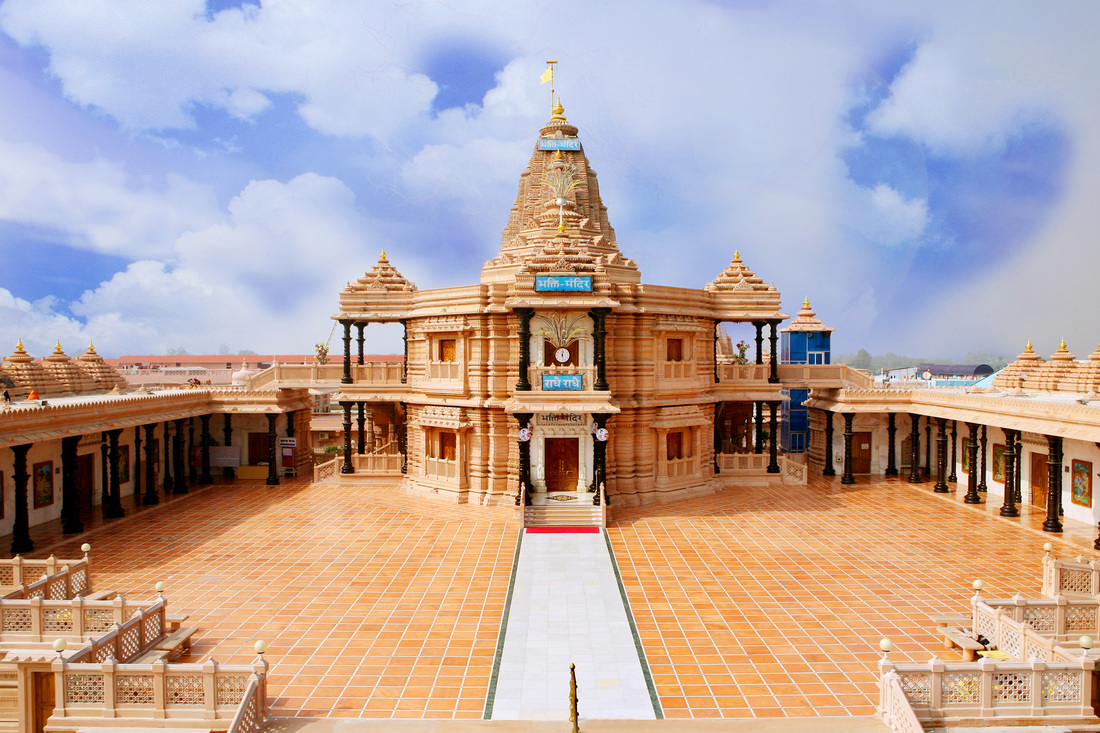
The literal meaning of the word mukti (मुक्ति) is liberation.
Let us understand the concept of liberation with an example. A convict was sentenced to time in prison for a crime that he had committed. The convict gets released from the prison after serving his time and he is now a free man, having attained freedom or mukti from the prison.
Hearing this question arise about who is being punished, since when, by who, till when etc. So, let us first understand some salient points of Spiritual philosophy.
As per the philosophy explained in our scriptures, there are three eternal entities:
Maya is inert and it is called the external power of God. It is insentient, which means that it does not have an intellect, mind or senses, hence it cannot do anything on its own. The Supreme Lord is the doer of all the actions of Maya. Lord Krishna says in the Gita -
Let us understand the concept of liberation with an example. A convict was sentenced to time in prison for a crime that he had committed. The convict gets released from the prison after serving his time and he is now a free man, having attained freedom or mukti from the prison.
Hearing this question arise about who is being punished, since when, by who, till when etc. So, let us first understand some salient points of Spiritual philosophy.
As per the philosophy explained in our scriptures, there are three eternal entities:
- Jeev: we, the individual soul are a part of God’s Jeev-Shakti also known as the power of existence.
- Maya: Maya is an inert power of God, possessing attributes that are contrary to those of God.
- Brahma-Supreme God: God is Almightly, Omnipresent and Omnipotent. He is the master of the powers of Jeev and Maya. God’s nature is sacchidanand (सच्चिदाननंद), sat denoting unlimited life, chit denoting unlimited knowledge and anand denoting unlimited bliss. Nature means the innate quality of an object e.g. the nature of fire is to give light and to burn, the nature of water is provide wetness. Similarly the nature of God is unlimited bliss.
Maya is inert and it is called the external power of God. It is insentient, which means that it does not have an intellect, mind or senses, hence it cannot do anything on its own. The Supreme Lord is the doer of all the actions of Maya. Lord Krishna says in the Gita -
दैवी ह्येषा गुणमयी मम माया दुरत्यया ॥
daivī hyeṣā guṇamayī mama māyā duratyayā, māmeva ye prapadyante māyāmetāṁ taranti te
daivī hyeṣā guṇamayī mama māyā duratyayā, māmeva ye prapadyante māyāmetāṁ taranti te
“This Maya, which is Mine, consists of the three gunas and no-one can overcome it on their own. Only those, who are fully surrendered to Me are able to cross this ocean of Maya, by My grace.”
Individual souls (see Jeev) are sentient and are referred to as the neutral (तटस्थ) power of God. The souls have eternally been given a free-will to either choose the area of Maya or the area of Brahma-Supreme God. The world of Maya is full of illusive fascination (see How Can Maya Dominate Jeev?). Individual beings are equipped with a material mind and an intellect to discern right from wrong. Both mind and intellect are made by Maya therefore are material. Due to its kinship with Maya, the material mind is naturally attracted to the world of Maya . Thus, individual beings have eternally turned away from God and have been searching for happiness in the area of Maya. Consequently, due to it’s impact, our minds are overpowered by ignorance and we start considering ourselves to be the body, forgetting our true identity as the soul. Thus, we consider all material objects or people related to the body, as our own and God who is our true originator appears to be so distant and non-important.
This is why all the material beings (see Jeev) are trapped by Maya and have been suffering since eternity. Everyone desires freedom from the sufferings of this world, or in other words freedom from Maya. It is impossible to get rid of Maya in any other form of life except in human form. Yet, before aiming for mukti, we must understand the true nature of mukti.
There are five kinds of mukti (liberation), which can be categorized in two major categories –
Individual souls (see Jeev) are sentient and are referred to as the neutral (तटस्थ) power of God. The souls have eternally been given a free-will to either choose the area of Maya or the area of Brahma-Supreme God. The world of Maya is full of illusive fascination (see How Can Maya Dominate Jeev?). Individual beings are equipped with a material mind and an intellect to discern right from wrong. Both mind and intellect are made by Maya therefore are material. Due to its kinship with Maya, the material mind is naturally attracted to the world of Maya . Thus, individual beings have eternally turned away from God and have been searching for happiness in the area of Maya. Consequently, due to it’s impact, our minds are overpowered by ignorance and we start considering ourselves to be the body, forgetting our true identity as the soul. Thus, we consider all material objects or people related to the body, as our own and God who is our true originator appears to be so distant and non-important.
This is why all the material beings (see Jeev) are trapped by Maya and have been suffering since eternity. Everyone desires freedom from the sufferings of this world, or in other words freedom from Maya. It is impossible to get rid of Maya in any other form of life except in human form. Yet, before aiming for mukti, we must understand the true nature of mukti.
There are five kinds of mukti (liberation), which can be categorized in two major categories –
- mukti of dualism: the individual soul remains separate from God
- mukti of non-Dualism: the individual soul becomes one with God
|
There are 4 types of mukti where the soul maintains its individualism. The devotees of Maha Vishnu aspire for these kinds of mukti.
Sārṣṭi mukti (सार्ष्टि) desire to attain the majesty of Maha Vishnu
Sāmīpya mukti (सामीप्य) desire to attain unceasing association of Maha Vishnu
Sālokya mukti (सालोक्य) desire to live in the abode of Maha Vishnu
Sārūpya mukti (सारूप्य) desire to attain the beauty of Maha Vishnu like gate-keepers of Vaikunth lok; Jaya and Vijay.
Those who attain dualism mukti, still have a mind, intellect, senses and a body. Thus they enjoy the bliss of God’s beauty, association, attributes and abode.
|
In scriptures there are many names for this mukti, namely
The followers of Gyan Marg do not believe in a physical form of God, so they desire for liberation from Maya. Supreme Brahma Shri Krishna is the ocean of highest bliss. The Nirakar Brahma (Impersonal, Formless) is the effulgence of His divine Body. Since the light that emanates from His body is also divine, there is bliss in that too. The Gyanis find the bliss of Brahma to be so enchanting that they forget all about themselves and the miseries. They are eternally liberated from the bondage of Maya. Thereby the cycle of death and birth ends forever and they are liberated from the miseries of Maya once and for all. However, it is only an inkling of real bliss because they don't enjoy God.
There are 3 parts [1] to enjoying anything;
Upon attainment of this mukti, the pure soul (without mind, intellect, senses or body) merges into impersonal form of Brahma-Supreme God forever. Since the enjoyer has become one with the bliss (object of enjoyment) there is no one to enjoy anything.
So, it is not wise to desire mukti in which the soul merges into Brahma () forever. In addition, once the soul merges into Brahma it can never come out of that state. Thus, the prospect of enjoying bliss in the future is also lost forever. The soul is liberated from sufferings but is unable to enjoy the bliss. Thus, only half the goal is achieved. This state can be compared to the state of eternal unconsciousness.
In a nutshell, it is unwise to desire for any of these 5 muktis. These souls see the all-majestic form of God with four arms and they lovingly respect their Lord. Also, they loose the opportunity to become His associates who have the privilege to enjoy His intimate pastimes.
God is the ocean of love and Jeev is an inseparable part of God. Being part of love our inherent desire is to attain love. Love is demonstrated by serving the beloved. So the concealed chief desire of human beings is “serving our beloved”. In the words of Chaitanya Mahaprabhu –
- Sayujjya mukti (सायुज्ज्य मुक्ति)
- Kaivalya mukti (कैवल्य मुक्ति)
- Ekatva mukti (एकत्व मुक्ति)
- Moksha (मोक्ष)
The followers of Gyan Marg do not believe in a physical form of God, so they desire for liberation from Maya. Supreme Brahma Shri Krishna is the ocean of highest bliss. The Nirakar Brahma (Impersonal, Formless) is the effulgence of His divine Body. Since the light that emanates from His body is also divine, there is bliss in that too. The Gyanis find the bliss of Brahma to be so enchanting that they forget all about themselves and the miseries. They are eternally liberated from the bondage of Maya. Thereby the cycle of death and birth ends forever and they are liberated from the miseries of Maya once and for all. However, it is only an inkling of real bliss because they don't enjoy God.
There are 3 parts [1] to enjoying anything;
- the one who enjoys (subject),
- the object (person or thing) which is enjoyed and
- enjoyment (the action).
Upon attainment of this mukti, the pure soul (without mind, intellect, senses or body) merges into impersonal form of Brahma-Supreme God forever. Since the enjoyer has become one with the bliss (object of enjoyment) there is no one to enjoy anything.
So, it is not wise to desire mukti in which the soul merges into Brahma () forever. In addition, once the soul merges into Brahma it can never come out of that state. Thus, the prospect of enjoying bliss in the future is also lost forever. The soul is liberated from sufferings but is unable to enjoy the bliss. Thus, only half the goal is achieved. This state can be compared to the state of eternal unconsciousness.
In a nutshell, it is unwise to desire for any of these 5 muktis. These souls see the all-majestic form of God with four arms and they lovingly respect their Lord. Also, they loose the opportunity to become His associates who have the privilege to enjoy His intimate pastimes.
God is the ocean of love and Jeev is an inseparable part of God. Being part of love our inherent desire is to attain love. Love is demonstrated by serving the beloved. So the concealed chief desire of human beings is “serving our beloved”. In the words of Chaitanya Mahaprabhu –
जीवेर स्वरूप होय कृष्णेर नित्य दास ।
Jīvēra svarūpa hōya kr̥ṣṇēra nitya dāsa.
Jīvēra svarūpa hōya kr̥ṣṇēra nitya dāsa.
“the true identify of jeev is 'eternal servant' of Shri Krishna.”
The desire to have a loving intimate relationship [2] with Shri Krishna can be fulfilled since He assumes a human form to impart divine love to the aspiring souls. In this form He conceals His divine powers, so that a human being can love Him freely as his Master, friend, son or beloved. Per the desire of the devotee, Shri Krishna reciprocates the relationship and intensity of love. As He said in Gita.
The desire to have a loving intimate relationship [2] with Shri Krishna can be fulfilled since He assumes a human form to impart divine love to the aspiring souls. In this form He conceals His divine powers, so that a human being can love Him freely as his Master, friend, son or beloved. Per the desire of the devotee, Shri Krishna reciprocates the relationship and intensity of love. As He said in Gita.
ये यथा मां प्रपद्यन्ते तांस्तथैव भजाम्यहम्॥
ye yatha maan prapadyante taanstathaiv bhajaamyaham.
ye yatha maan prapadyante taanstathaiv bhajaamyaham.
“The way in which soul lovingly relates to Me, I reciprocate those feelings.”
So, mukti means eternal freedom from material sufferings yet it is our greatest enemy in disguise. Like Chaitanya Mahaprabhu said
So, mukti means eternal freedom from material sufferings yet it is our greatest enemy in disguise. Like Chaitanya Mahaprabhu said
… तारो मध्ये मोक्ष वांछा कैतव प्रधान
taaro madhye moksh vaanchha kaitav pradhaan
taaro madhye moksh vaanchha kaitav pradhaan
“... of all the deceptions mukti is the greatest”.
It deprives humans from their prime goal of attaining love bliss for eternity. So, wisely love Shri Krishna as your beloved and attain the highest bliss forever.
It deprives humans from their prime goal of attaining love bliss for eternity. So, wisely love Shri Krishna as your beloved and attain the highest bliss forever.
भुक्ति-मुक्ति-स्पृहा यावत् पिशाची हृदि वर्तते । तावद् भक्ति-सुखस्यात्र कथम् अभ्युदयो भवेत् ॥१.२.२२॥
bhukti-mukti-spṛhā yāvat, piśācī hṛdi vartate, tāvad bhakti-sukhasyātra, katham abhyudayo bhavet
bhukti-mukti-spṛhā yāvat, piśācī hṛdi vartate, tāvad bhakti-sukhasyātra, katham abhyudayo bhavet
"If you desire for bhakti then totally uproot the desire for material enjoyment (Bhukti) or liberation (Mukti) from your mind or else bhakti will not take root.”



